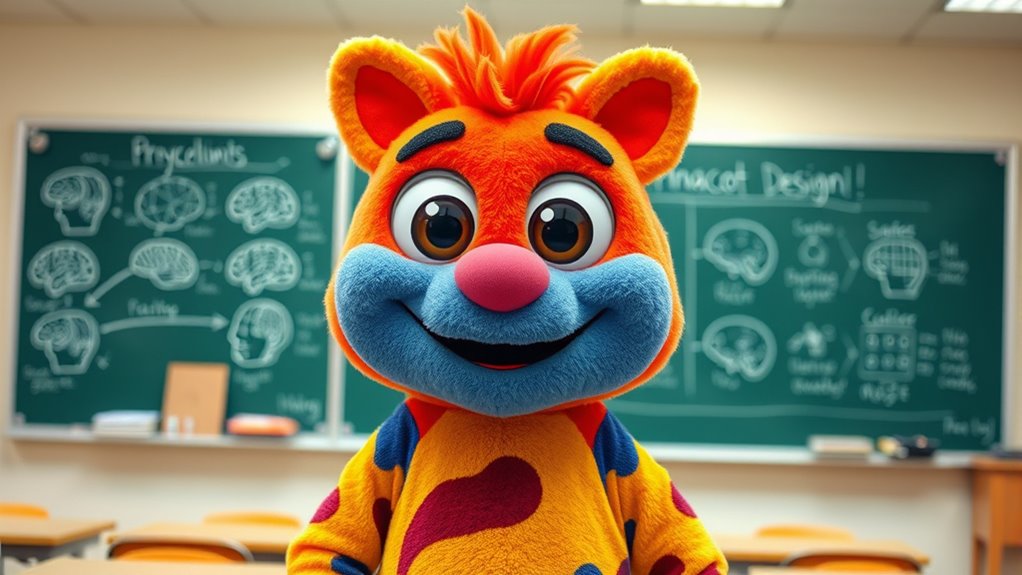When designing a mascot, focusing on color psychology, simple and recognizable shapes, and expressive facial features helps create a lasting emotional connection. Bright colors energize your audience, while symmetry and friendly expressions foster trust. Catchy silhouettes and cultural awareness ensure your mascot resonates across diverse groups. Consistent style builds brand recognition, and storytelling deepens bonds. Keep these principles in mind, and you’ll discover how to craft mascots that truly connect — the details matter as you explore further.
Key Takeaways
- Colors evoke specific emotions and cultural meanings, influencing mascot appeal and brand perception.
- Simple, recognizable shapes and strong silhouettes enhance memorability and visual impact.
- Symmetry and expressive facial features foster trust, approachability, and emotional connection.
- Storytelling and relatable themes deepen audience engagement and emotional bonds with the mascot.
- Consistent design style and proportions reinforce brand recognition and build long-term loyalty.
The Impact of Color Psychology on Mascot Appeal

Colors play a crucial role in shaping how mascots are perceived and remembered. Your choice of color association can evoke specific emotions and reactions, making your mascot more appealing and relatable. Bright reds and yellows often symbolize energy and optimism, capturing attention quickly. Meanwhile, cooler tones like blue convey trust and reliability, fostering brand consistency over time. When you select colors intentionally, you strengthen your brand identity, ensuring your mascot aligns with your company’s values and messaging. Consistent use of these colors across marketing materials reinforces recognition and builds a memorable connection with your audience. Understanding how color psychology influences perception helps you craft a mascot that not only attracts attention but also sustains positive brand associations long-term.
Shape and Form: How Silhouettes Influence Perception
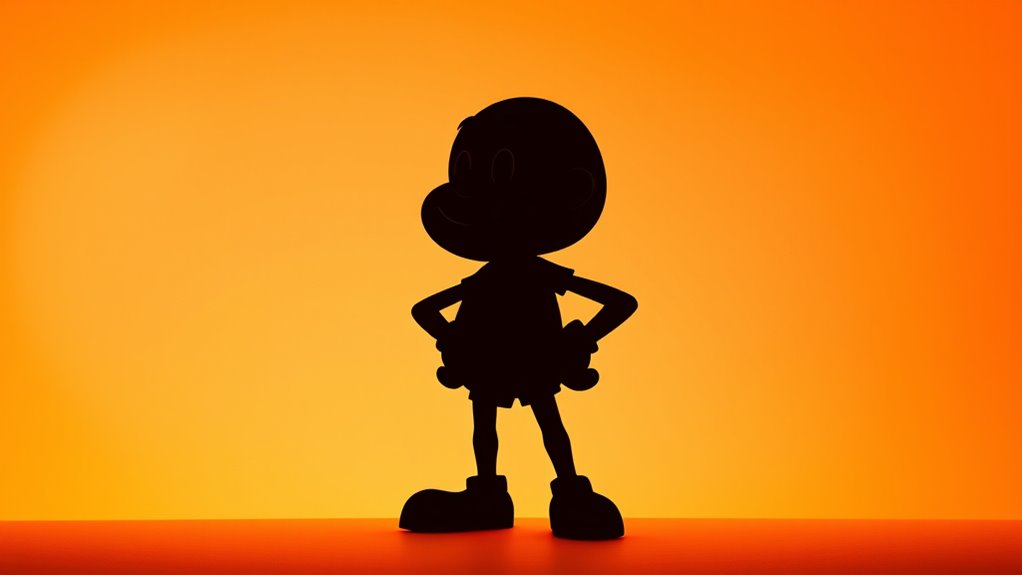
Your mascot’s silhouette is essential in grabbing attention and making a strong impression. Recognizable outlines help people instantly identify and remember your mascot. Additionally, symmetrical shapes create a sense of comfort and trust. Understanding geometric principles can help in designing effective and appealing silhouettes.
Recognizable Outlines Capture Attention
Recognizable outlines are essential in mascot design because they immediately draw attention and make a symbol memorable. Strong silhouettes help viewers quickly identify the mascot, even from a distance. By leveraging cultural symbolism, you can create outlines that resonate with specific audiences, strengthening emotional connections. Over time, mascot evolution shows how simple shapes become iconic, maintaining relevance while adapting to changing trends. Clear, distinct outlines ensure your mascot stands out amid crowded visuals, capturing attention instantly. Remember, a simple, memorable shape can transcend language barriers and cultural differences, making your mascot more versatile and impactful. Focus on creating outlines that are easy to recognize and emotionally meaningful, guiding viewers’ perception and fostering a lasting impression. Additionally, incorporating natural materials and authentic shapes can enhance the familiarity and warmth of your mascot design, reinforcing its connection to the farmhouse aesthetic.
Symmetry Promotes Comfort
Symmetry in mascot design creates a sense of harmony that naturally comforts viewers. When your mascot’s shape is balanced and symmetrical, it signals stability and order, making people feel at ease. This sense of balance helps viewers process the silhouette effortlessly, fostering trust and positive feelings. Symmetrical shapes are predictable, which reinforces feelings of safety and familiarity. As a result, your mascot becomes more approachable and memorable. The harmony achieved through symmetry not only draws attention but also establishes an emotional connection. When designing, aim for balanced proportions and mirrored features to maximize comfort. In essence, symmetry in shape and form ensures your mascot’s silhouette promotes a welcoming, harmonious impression that resonates with audiences. Additionally, understanding the impact of color accuracy and visual clarity can further enhance the overall effectiveness of your mascot’s design.
Facial Expressions and Emotional Connection
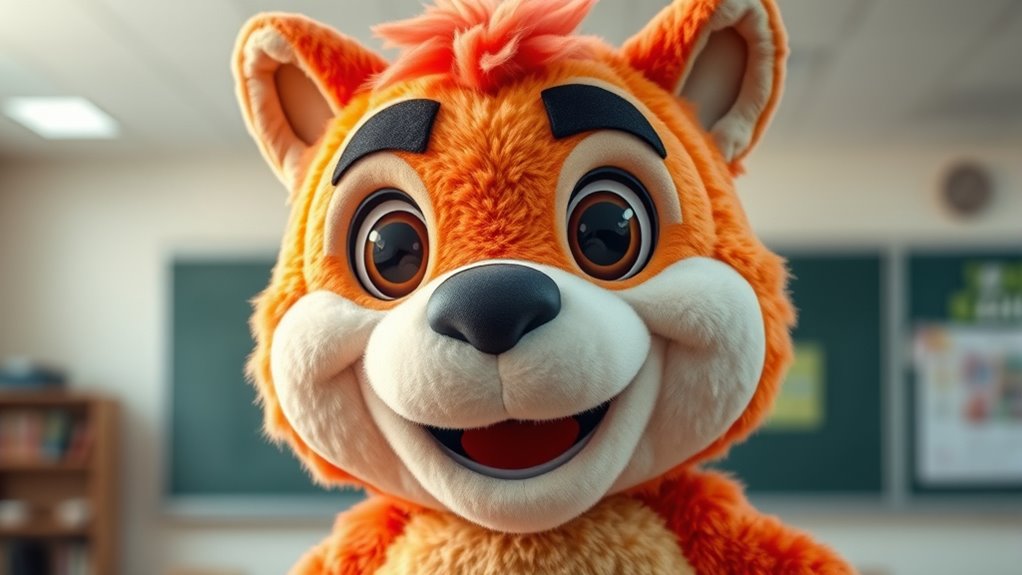
Your mascot’s facial expressions play a vital role in creating an emotional bond. Expressive eyes and warm smiles can make your mascot feel more relatable and inviting. When the face is symmetrical, it naturally builds trust and fosters a deeper connection with your audience. Additionally, incorporating emotional expression into your mascot’s design can significantly enhance its ability to communicate feelings effectively.
Expressive Eyes Matter
Expressive eyes play a crucial role in conveying a mascot’s personality and forging an emotional bond with the audience. When you focus on eye contact, your mascot appears more engaged and trustworthy, encouraging connection. Emphasizing eyelash details can enhance the expressiveness of the eyes, making them appear more lively and relatable. A wide-eyed look can evoke curiosity or excitement, while softer, focused eyes foster warmth and friendliness. Use eye positioning to guide emotions—upward gaze for innocence, direct eye contact for confidence. Remember, the eyes are the window to the mascot’s soul; subtle adjustments create powerful emotional cues. By paying attention to eye contact and eyelash emphasis, you make your mascot more memorable and emotionally resonant, strengthening the bond with your audience. Additionally, understanding anime culture and storytelling can inspire more expressive and appealing mascot designs that resonate with diverse audiences.
Smiles Foster Warmth
A warm, genuine smile can instantly make a mascot more approachable and likable, creating an emotional connection with your audience. When your mascot’s face lights up with a friendly smile, it signals openness and friendliness. Coupled with a warm voice tone, this makes viewers feel comfortable and engaged. Remember, smiles also carry cultural symbolism—what’s considered friendly in one culture may differ in another. So, guarantee your mascot’s expression matches your audience’s cultural expectations. A sincere smile communicates positive emotions without words, fostering trust and warmth. Keep the expression natural and confident to strengthen the emotional bond. Additionally, understanding Kia Tuning options can help craft a more personalized and relatable mascot design that resonates with car enthusiasts. Ultimately, a well-crafted smile, combined with appropriate voice tone and cultural awareness, helps your mascot forge genuine connections that last.
Facial Symmetry Builds Trust
Facial symmetry plays a significant role in how you perceive a mascot’s trustworthiness and emotional appeal. When a face is symmetrical, facial recognition becomes easier, making it more familiar and approachable. This familiarity boosts trust development because your brain instinctively associates symmetrical features with health and stability. Symmetry also enhances emotional connection, as it signals honesty and openness. Consider the following factors:
| Feature | Effect on Trust | Emotional Impact |
|---|---|---|
| Symmetry | Easier facial recognition | Increases warmth |
| Expression | Communicates friendliness | Fosters connection |
| Proportions | Signals stability | Builds confidence |
Cultural Considerations in Mascot Design
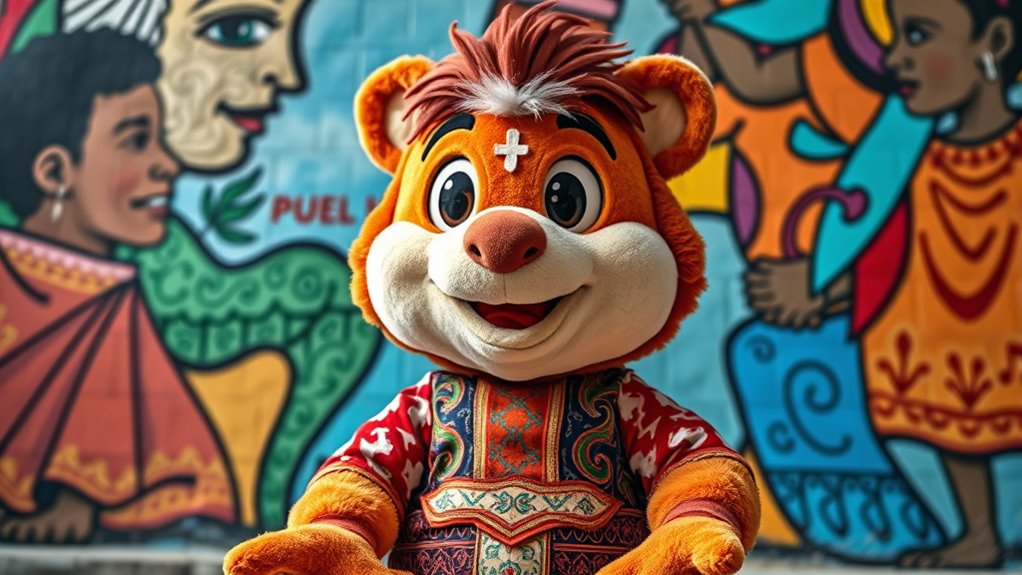
When designing a mascot, understanding cultural considerations is crucial to guarantee it resonates positively with diverse audiences. Cultural symbolism plays a key role, as certain images or colors may carry different meanings across regions. For example, a color associated with luck in one culture might symbolize mourning in another. Similarly, regional aesthetics influence design choices; what appeals visually in one area could be off-putting elsewhere. Respecting cultural nuances helps avoid unintended offense and fosters connection. Researching local traditions, beliefs, and symbols ensures your mascot aligns with the audience’s values. Incorporating AI-driven cultural analysis can further enhance understanding of regional sensitivities. By thoughtfully integrating cultural symbolism and regional aesthetics, you create a mascot that feels authentic, respectful, and engaging to diverse communities. This approach enhances brand perception and broadens your reach effectively.
The Role of Simplicity and Memorability
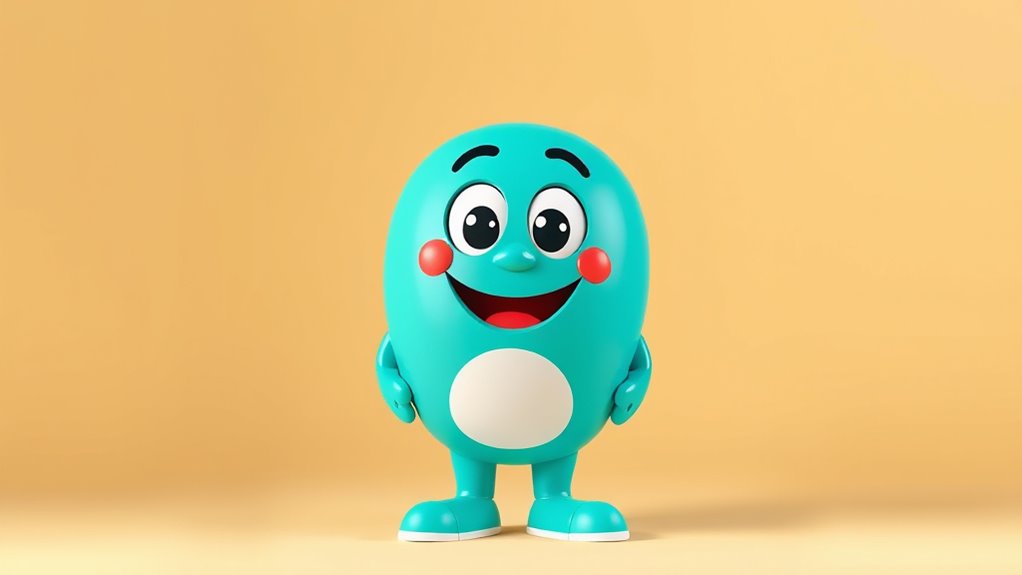
Simplicity and memorability are essential qualities that make a mascot truly effective. They help your mascot stand out and stick in people’s minds. To achieve this, focus on minimalist aesthetics, which strip away unnecessary details. This creates a clean, recognizable look. Additionally, maintaining design consistency across various platforms reinforces familiarity. Here are key ideas to contemplate:
- Use simple shapes and bold lines for instant recognition.
- Limit color palettes to enhance visual impact.
- Keep details minimal to avoid clutter and confusion.
- Ensure consistent style and proportions across all mascot representations.
Building Brand Loyalty Through Mascot Interaction
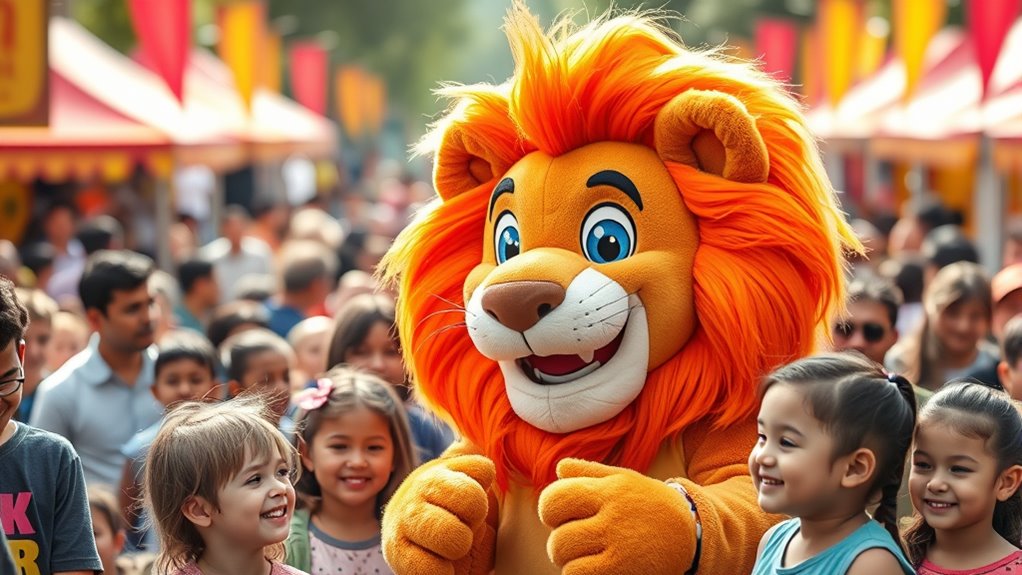
Building brand loyalty hinges on how effectively your mascot engages with your audience. To foster connection, use storytelling techniques that evoke emotion and create memorable moments. Mascot customization allows you to tailor your character’s appearance and personality, making it more relatable. When your mascot interacts authentically, it builds trust and familiarity. Incorporating Pimple Patch themes into your mascot’s story can further enhance relatability by addressing common skin concerns. When your mascot interacts authentically, it builds trust and familiarity.
Frequently Asked Questions
How Does Mascot Movement Influence Audience Perception?
Your mascot’s movement plays a vital role in shaping audience perception. When you use clear gesture cues, you communicate confidence, friendliness, or excitement, making your mascot more relatable. Dynamic, lively movements generate emotional resonance, drawing viewers in and fostering positive feelings. Conversely, stiff or awkward gestures can create confusion or discomfort. By intentionally controlling your mascot’s movement, you enhance its appeal and strengthen the emotional connection with your audience.
What Psychological Effects Do Mascot Size and Scale Have?
Ever wonder how size perception impacts your feelings? Larger mascots often evoke feelings of power and safety, while smaller ones can seem more approachable and friendly. Scale psychology shows that exaggerated sizes grab attention and influence perceived importance. By manipulating mascot size and scale, you shape audience perceptions, making them feel more secure or excited. Wouldn’t you want your mascot to leave a lasting, positive impression?
Can Mascots’ Design Elements Impact Brand Trust?
Your mascot’s design elements can substantially impact brand trust, especially through color symbolism and cultural relevance. When you choose colors that resonate positively and align with your target audience’s cultural values, you foster familiarity and credibility. Thoughtful design demonstrates that you understand and respect your audience’s background, building trust. So, pay attention to these elements—they’re key to creating a mascot that enhances your brand’s reputation and connection.
How Do Mascots Affect Consumer Decision-Making Processes?
Like a compass guiding your choices, mascots influence your decision-making by fostering emotional engagement. They become symbols you trust, strengthening brand loyalty and making you more likely to choose their products. Mascots evoke positive feelings and memories, which subtly steer your preferences. This emotional connection makes you more receptive to brand messages, ultimately guiding your decisions and reinforcing your loyalty through a relatable, memorable character.
What Role Does Personality Projection Play in Mascot Effectiveness?
Personality projection plays a vital role in mascot effectiveness by creating personality alignment with your target audience. When your mascot’s traits resonate emotionally, it fosters a stronger emotional connection, enhancing brand loyalty. This alignment makes your mascot more relatable and memorable, boosting its influence. By focusing on emotional resonance, you guarantee your mascot’s personality complements your brand, making your marketing efforts more impactful and compelling for your audience.
Conclusion
By understanding the psychology behind mascot design, you can craft a character that sparks joy and loyalty. Picture your mascot as a vibrant splash of color, a friendly silhouette that invites connection, and a face that resonates emotionally. When you consider cultural nuances and keep it simple, your mascot becomes more than just a symbol—it transforms into a memorable friend that fuels brand loyalty, like a familiar face you trust and cherish in every interaction.
